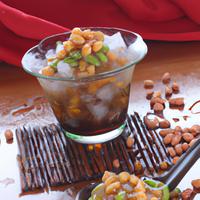
1 serving (300 grams) contains 250 calories, 4.0 grams of protein, 2.0 grams of fat, and 60.0 grams of carbohydrates.

Log this food in SnapCalorie

Nutrition Information
Calories |
196.9 | ||
|---|---|---|---|
% Daily Value* |
|||
| Total Fat | 1.6 g | 2% | |
| Saturated Fat | 0.8 g | 4% | |
| Polyunsaturated Fat | 0 g | ||
| Cholesterol | 0 mg | 0% | |
| Sodium | 39.4 mg | 1% | |
| Total Carbohydrates | 47.2 g | 17% | |
| Dietary Fiber | 2.4 g | 8% | |
| Sugars | 35.4 g | ||
| protein | 3.1 g | 6% | |
| Vitamin D | 0 mcg | 0% | |
| Calcium | 39.4 mg | 3% | |
| Iron | 0.8 mg | 4% | |
| Potassium | 118.1 mg | 2% | |
* Percent Daily Values are based on a 2,000 calorie diet. Your daily values may be higher or lower depending on your calorie needs.
Food Attributes
Source of Calories
About Ice kacang
Ice kacang, also known as ais kacang, is a popular Malaysian and Singaporean dessert that originated from Southeast Asia. Traditionally served as a refreshing treat, it features a base of finely shaved ice topped with sweetened condensed milk or evaporated milk, flavored syrups, and a variety of colorful toppings. Common ingredients include red beans, sweet corn, grass jelly, palm seeds, and agar-agar, often garnished with roasted peanuts or ice cream for added indulgence. While ice kacang can be a hydrating and fiber-rich option due to its fruit, bean, or jelly components, it is typically high in added sugars from syrups and condensed milk, making it a dessert best enjoyed in moderation. Its vibrant presentation and customizable ingredients make it both a cultural delight and a versatile treat for hot tropical climates.



